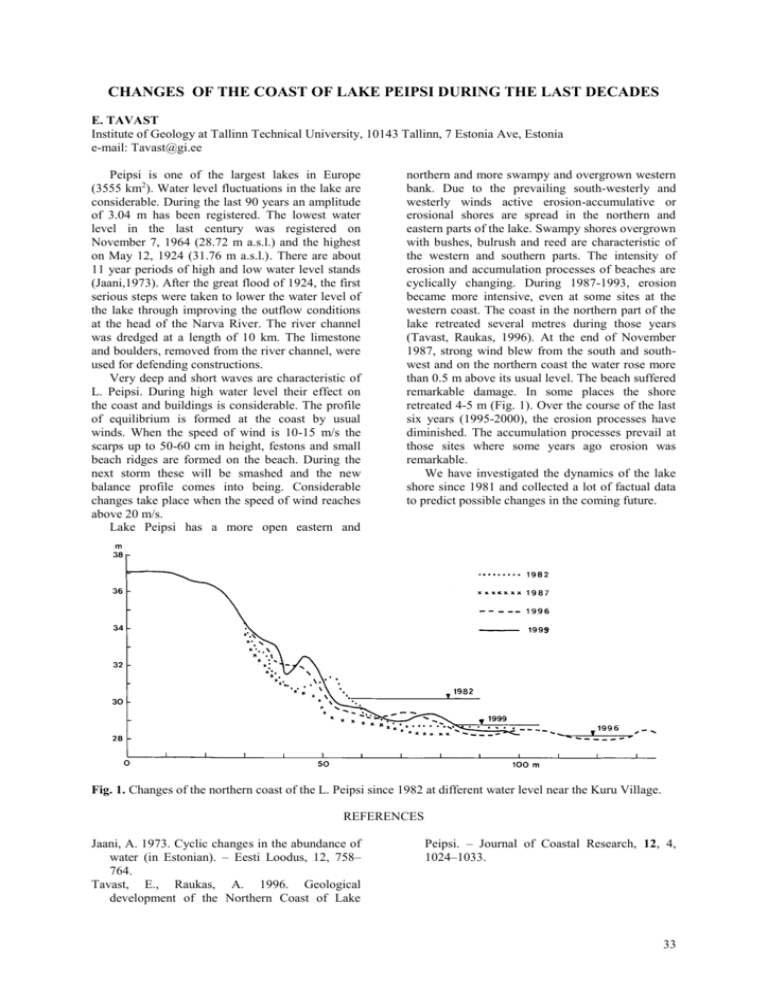e. tavast
advertisement

CHANGES OF THE COAST OF LAKE PEIPSI DURING THE LAST DECADES E. TAVAST Institute of Geology at Tallinn Technical University, 10143 Tallinn, 7 Estonia Ave, Estonia e-mail: Tavast@gi.ee Peipsi is one of the largest lakes in Europe (3555 km2). Water level fluctuations in the lake are considerable. During the last 90 years an amplitude of 3.04 m has been registered. The lowest water level in the last century was registered on November 7, 1964 (28.72 m a.s.l.) and the highest on May 12, 1924 (31.76 m a.s.l.). There are about 11 year periods of high and low water level stands (Jaani,1973). After the great flood of 1924, the first serious steps were taken to lower the water level of the lake through improving the outflow conditions at the head of the Narva River. The river channel was dredged at a length of 10 km. The limestone and boulders, removed from the river channel, were used for defending constructions. Very deep and short waves are characteristic of L. Peipsi. During high water level their effect on the coast and buildings is considerable. The profile of equilibrium is formed at the coast by usual winds. When the speed of wind is 10-15 m/s the scarps up to 50-60 cm in height, festons and small beach ridges are formed on the beach. During the next storm these will be smashed and the new balance profile comes into being. Considerable changes take place when the speed of wind reaches above 20 m/s. Lake Peipsi has a more open eastern and northern and more swampy and overgrown western bank. Due to the prevailing south-westerly and westerly winds active erosion-accumulative or erosional shores are spread in the northern and eastern parts of the lake. Swampy shores overgrown with bushes, bulrush and reed are characteristic of the western and southern parts. The intensity of erosion and accumulation processes of beaches are cyclically changing. During 1987-1993, erosion became more intensive, even at some sites at the western coast. The coast in the northern part of the lake retreated several metres during those years (Tavast, Raukas, 1996). At the end of November 1987, strong wind blew from the south and southwest and on the northern coast the water rose more than 0.5 m above its usual level. The beach suffered remarkable damage. In some places the shore retreated 4-5 m (Fig. 1). Over the course of the last six years (1995-2000), the erosion processes have diminished. The accumulation processes prevail at those sites where some years ago erosion was remarkable. We have investigated the dynamics of the lake shore since 1981 and collected a lot of factual data to predict possible changes in the coming future. Fig. 1. Changes of the northern coast of the L. Peipsi since 1982 at different water level near the Kuru Village. REFERENCES Jaani, A. 1973. Cyclic changes in the abundance of water (in Estonian). – Eesti Loodus, 12, 758– 764. Tavast, E., Raukas, A. 1996. Geological development of the Northern Coast of Lake Peipsi. – Journal of Coastal Research, 12, 4, 1024–1033. 33









